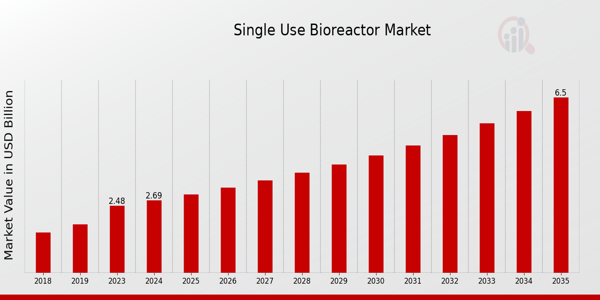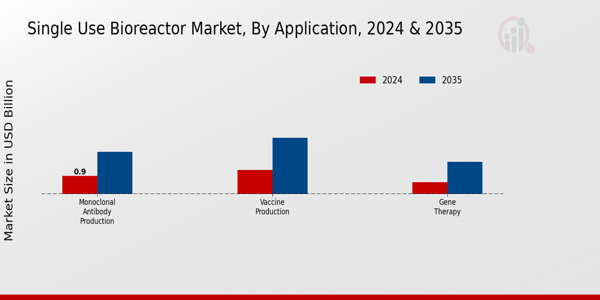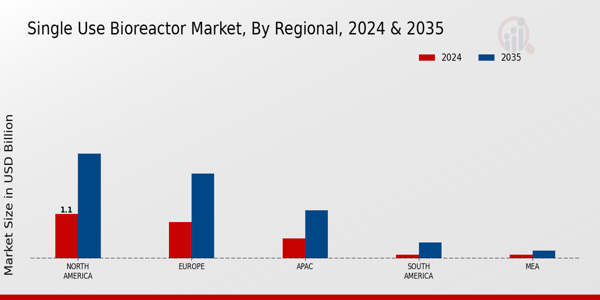Single-Use Bioreactor Market Overview
As per MRFR analysis, the Single-Use Bioreactor Market Size was estimated at 2.48 (USD Billion) in 2023. The Single-Use Bioreactor Market Industry is expected to grow from 2.69(USD Billion) in 2024 to 6.5 (USD Billion) by 2035. The Single-Use Bioreactor Market CAGR (growth rate) is expected to be around 8.36% during the forecast period (2025 - 2035).
Key Single-Use Bioreactor Market Trends Highlighted
The Global Single-Use Bioreactor Market is significantly driven by the rising demand for biopharmaceutical production and advancements in biotechnology. As more companies turn to single-use systems, the need for improved efficiency, flexibility, and reduced contamination risk is vital. These bioreactors stand out due to their ability to streamline manufacturing processes, which in turn enhances productivity while minimizing operational costs. Furthermore, the growing trend toward personalized medicine is increasing the need for scalable and adaptive production methods, further propelling market growth.
Opportunities within the market continue to expand as industries leverage the advantages offered by single-use technologies.Increasing investments in research and development, particularly in the fields of cell-based therapies and vaccine production, provide a fertile ground for innovation. As regulatory frameworks evolve and become more accommodating to these types of manufacturing processes, companies can capitalize on the growing need for efficient and compliant production solutions. There is also a notable shift toward automation and digitalization in the bioprocessing arena, presenting further opportunities for integration with single-use bioreactors.
Recent trends indicate a surge in the adoption of advanced materials and designs that enhance the performance of single-use bioreactors.Developments in sensor technology and real-time monitoring capabilities are becoming more common, enabling manufacturers to optimize production conditions. Additionally, sustainability concerns are prompting the industry to explore eco-friendly materials for bioreactors, positioning the market toward more responsible innovation. Overall, the single-use bioreactor market is set to experience ongoing evolution, driven by technological advancements, industry demands, and the continuous quest for improved biomanufacturing solutions.

Source: Primary Research, Secondary Research, MRFR Database and Analyst Review
Single-Use Bioreactor Market Drivers
Increased Demand for Biopharmaceuticals
Biopharmaceuticals have garnered global attention due to their widespread usage, which heavily impacts the growth of the Global Single-Use Bioreactor Market Industry. As more pharmaceutical companies seek to innovate through monoclonal antibodies, vaccines, and even gene therapies, the efficacy of the production processes and systems becomes very important. Single-Use bioreactors, for example, are designed to be more efficient in use and operation, resulting in a lower risk of cross-contamination and a high degree of flexibility as compared to traditional bioreactors.
These systems prove to be extremely beneficial to the overall Biomanufacturing process and save time while being responsive to multiple biopharmaceuticals at a time. There is still more room for innovation, especially in regard to the shift towards personalized medicine, as it increases the demand for smaller doses. Exactly like Single-Use bioreactors, there is potential to further modify other systems to achieve a high level of operational efficiency. With the expansion coming towards the Single-Use Bioreactor market, projections show an immense boost in valuation, as market estimates put it at USD 3.97 Billion by 2035. This bolsters the entire industry for Global Single-Use Bioreactors, which is expected to excel in the coming years.
Single-Use Single-Use Technological Advancements in Bioreactor Designs
The evolving technology landscape is another key driver for the Global Single-Use Bioreactor Market Industry. Innovations in bioreactor designs, materials, and monitoring systems are facilitating greater efficiency and reliability in biomanufacturing. Enhanced automation and real-time monitoring capabilities are optimizing production processes, leading to faster turnaround times and reduced costs. These advancements not only improve productivity but also ensure higher-quality product yields, catering to the stringent regulatory requirements of the biopharmaceutical industry.As technologies continue to evolve, the Global Single-Use Bioreactor Market Industry stands to benefit from the introduction of smarter solutions that further enhance operational workflows.
Rising Focus on Cost-Effective Manufacturing Solutions
Cost management is a critical aspect of biomanufacturing, contributing to the growth of the Global Single-Use Bioreactor Market Industry. Companies are increasingly seeking ways to reduce operational costs related to production facilities, materials, and labor. Single-use bioreactors minimize the expenses associated with cleaning, sterilization, and validation of traditional bioreactors. Their disposable nature allows manufacturers to avoid the high overhead costs linked to maintaining large-scale production facilities while still achieving high-quality output.Additionally, the rapid establishment of production lines using single-use systems accelerates time-to-market for bioproducts, further enhancing their appeal in an industry focused on efficiency and cost-effectiveness.
Single-Use Bioreactor Market Segment Insights
Single-Use Bioreactor Market Application Insights
The Global Single-Use Bioreactor Market revenue is witnessing robust growth, especially when examining the Application segment, which encompasses key areas such as Monoclonal Antibody Production, Vaccine Production, and Gene Therapy. As of 2024, the market for Monoclonal Antibody Production is valued at 0.9 USD Billion, while Vaccine Production holds a significant value of 1.2 USD Billion. Gene Therapy, although smaller in comparison, shows a valuation of 0.59 USD Billion in the same year. The valuation of Vaccine Production reflects its essential role in contemporary healthcare, particularly highlighted by the surge in demand during global health emergencies.
This segment is pivotal as vaccines are crucial for preventing infectious diseases, thereby reinforcing the necessity of single-use bioreactors in their manufacturing process. Looking forward, by 2035, Monoclonal Antibody Production is projected to grow to 2.1 USD Billion, demonstrating strong market traction, as monoclonal antibodies represent critical therapeutic agents in treating chronic diseases and autoimmune disorders. This segment commands a majority holding within the overall market due to its expansive application in pharmaceutical research and clinical trials.
Vaccine Production is also anticipated to reach a value of 2.8 USD Billion by 2035, underscoring its continuous relevance, especially in the face of emerging infectious diseases and the execution of immunization programs on a global scale. Meanwhile, Gene Therapy, with its growth forecast to reach 1.6 USD Billion, signifies its rising importance in targeting specific genetic disorders and diseases, thereby reflecting a burgeoning interest in personalized medicine. The Global Single-Use Bioreactor Market statistics indicate that these applications are interconnected, as advancements in one area may drive innovation in another.
For example, the need for scalable and efficient production methods in Monoclonal Antibody and Vaccine Production influences the development of single-use technologies, thus enhancing their operational capabilities. The market growth is fueled by increased investments in biopharmaceuticals, a surge in research and development activities, and the rising adoption of single-use systems for their benefits in reducing contamination risks and operational costs. However, challenges such as regulatory compliance and the requirement for consistent quality in production continue to pose significant factors that players in the industry must address.
Overall, the analysis of the Global Single-Use Bioreactor Market segmentation, particularly within the Application area, reveals a marketplace that is not only growing but is also shaped by the increasing need for innovative and efficient solutions in bioprocessing. As the industry progresses, opportunities will continue to emerge, driving further expansion within Monoclonal Antibody Production, Vaccine Production, and Gene Therapy, making the Application segment a vital focus for stakeholders and entities operating in the Global Single-Use Bioreactor Market industry.

Source: Primary Research, Secondary Research, MRFR Database and Analyst Review
Single-Use Bioreactor Market Type Insights
The Global Single-Use Bioreactor Market is expanding significantly, with a projected revenue of 2.69 billion USD in 2024 and increasing as the industry grows. This market encompasses various types of bioreactors, which play a critical role in biopharmaceutical production. Among these, the Plastic Bioreactor has emerged as a prominent choice due to its cost-effectiveness and flexibility, allowing for easier handling and transport. On the other hand, the Stainless Steel Bioreactor remains significant in larger-scale productions, known for its durability and efficiency in high-volume processes.
The Celled Bioreactor, although less common, provides advantages in specific applications, particularly for cellular therapies. The diversity in the Global Single-Use Bioreactor Market segmentation reflects evolving customer demands and technological advancements, contributing to the overall market growth. Market dynamics will continue to evolve, presenting opportunities for stakeholders to harness the latest technologies for improved bioprocessing.
Single-Use Bioreactor Market Scale Insights
The Global Single-Use Bioreactor Market is witnessing significant growth, with the overall market projected to be valued at 2.69 billion USD in 2024 and reaching approximately 6.5 billion USD by 2035. The Scale segment is a critical area of focus within this market, comprising Laboratory Scale, Pilot Scale, and Industrial Scale applications. Laboratory Scale bioreactors play a vital role in research and development, allowing for efficient experimentation and validation of bioprocesses, while Pilot Scale bioreactors serve as a crucial bridge for scaling up processes from lab to production.
Industrial Scale bioreactors dominate the market due to their capacity to support commercial production runs, meeting rising demand for biologics and personalized medicine. The growth in the Global Single-Use Bioreactor Market is driven by an increase in biopharmaceutical production and a shift towards disposable technologies that enhance efficiency and reduce cross-contamination. However, challenges persist, including the need for more extensive regulatory assessments and the high initial costs associated with these systems. Opportunities exist for innovation and technology advancements in bioreactor design, which can further enhance productivity in the Global Single-Use Bioreactor Market industry.
Single-Use Bioreactor Market End User Insights
In 2024, the Global Single-Use Bioreactor Market revenue is projected to reach approximately 2.69 USD Billion, showcasing significant growth potential in the upcoming years. This market, particularly through its End User segment, includes key players such as Pharmaceutical Companies, Biotechnology Companies, and Research Institutes. Pharmaceutical Companies are crucial, as they increasingly adopt Single-Use Bioreactors for their efficiency and cost-effectiveness, facilitating the rapid development of biopharmaceuticals.
Biotechnology Companies significantly contribute to market growth due to their focus on innovative therapies, relying on the flexibility and scalability of single-use technologies.Research Institutes play an important role as well, supporting advancements in bioprocessing applications and driving innovation. The Global Single-Use Bioreactor Market segmentation reflects these dynamics, underscoring the importance of each End User in shaping industry trends.
The market growth is driven by the increasing demand for biologics and the need for efficient manufacturing processes, while challenges such as regulatory compliance and initial setup costs persist. Nevertheless, the opportunities for growth in emerging markets and technological advancements remain promising for the Global Single-Use Bioreactor Market industry.
Single-Use Bioreactor Market Regional Insights
The Global Single-Use Bioreactor Market is positioned for considerable growth across various regional segments. In 2024, North America leads with a valuation of 1.1 USD Billion, reflecting its dominance due to advanced biomanufacturing practices and strong R investments. Europe follows, valued at 0.9 USD Billion, benefiting from stringent regulatory frameworks that enhance safety and efficiency in bioprocessing. The APAC region shows significant potential, with a valuation of 0.5 USD Billion, driven by expanding pharmaceutical industries and government support for biotechnology.
South America, with a value of 0.1 USD Billion, remains at the nascent stage but presents opportunities due to increasing healthcare investments. Lastly, the MEA segment holds a value of 0.09 USD Billion, focusing on improving biopharmaceutical production capabilities. Overall, these regional dynamics underscore varying growth drivers, with North America and Europe currently holding the majority in market share, while APAC is gradually emerging as a significant player in the Global Single-Use Bioreactor Market landscape.

Source: Primary Research, Secondary Research, MRFR Database and Analyst Review
Single-Use Bioreactor Market Key Players and Competitive Insights
The Global Single-Use Bioreactor Market has witnessed significant growth due to the increasing demand for biopharmaceuticals and the advantages provided by single-use technology over traditional stainless-steel systems. As the industry continues to expand, competition has intensified among various players looking to establish a strong foothold. Factors such as innovation, technology advancements, and strategic partnerships contribute to shaping the competitive landscape. Companies are focusing on developing robust bioreactor solutions that not only fulfill regulatory compliance but also enhance productivity, reduce contamination risks, and lower operating costs.
The market is further influenced by the rising popularity of personalized medicine and continuous manufacturing processes, creating opportunities for players to innovate and meet specific client needs.Repligen is positioned as a key player in the Global Single-Use Bioreactor Market, primarily recognized for its strong emphasis on innovation and high-quality products. The company’s comprehensive range of single-use bioreactor systems is designed to meet the increasing demands of biopharmaceutical production, positioning them as a reliable choice for manufacturers looking to improve their operational efficiency.
Repligen’s commitment to ensuring the integrity and performance of its bioreactor systems enhances its market presence. Furthermore, their continuous investments in research and development enable the introduction of advanced technologies that address the evolving needs of their customers, allowing them to stay ahead of the competition by offering scalable and flexible solutions tailored to various bioprocessing applications.Waters Corporation has established itself as a notable entity within the Global Single-Use Bioreactor Market, providing innovative solutions that cater to the needs of the biopharmaceutical industry. Their focus on integrating cutting-edge technology with bioprocess development enhances the efficiency and effectiveness of single-use systems.
Waters Corporation takes pride in its strong background in analytical sciences, which empowers it to offer state-of-the-art bioreactor solutions that include advanced monitoring and control capabilities, ensuring optimal conditions for bioprocessing. Their broad product portfolio, combined with a commitment to delivering high-quality solutions, strengthens their position in the market. By fostering strategic collaborations and partnerships, Waters Corporation continues to enhance its offerings, further solidifying their standing in the highly competitive landscape of single-use bioreactor technology.
Key Companies in the Single-Use Bioreactor Market Include
- Repligen
- Waters Corporation
- Eppendorf
- Fujifilm Irvine Scientific
- Merck KGaA
- Danaher Corporation
- Corning
- Pall Corporation
- Parker Hannifin
- Sartorius
- Thermo Fisher Scientific
- Mobius Biomedical
- BD
- Lonza
- GE Healthcare
Single-Use Bioreactor Market Industry Developments
Recent developments in the Global Single-Use Bioreactor Market reflect significant growth and innovation. Companies like Repligen and Sartorius have continued to expand their product portfolios, addressing the increasing demand for flexible and efficient bioprocessing solutions. Waters Corporation and Eppendorf have launched new systems and products aimed at enhancing the performance of single-use bioreactors, making strides toward improving cell culture and productivity. Notable mergers and acquisitions have been observed, including Danaher Corporation’s acquisition of GE Healthcare's biopharma business, which strengthens its position in the single-use bioreactor segment.
Merck KGaA and Thermo Fisher Scientific have also been active in partnerships aimed at advancing bioprocess capabilities. The market's valuation is witnessing a surge, with increasing investments in biotechnology resulting in a heightened need for advanced manufacturing solutions. As a result, companies such as Pall Corporation and Corning continue to see significant growth, driven by the rising adoption of single-use technologies among biopharmaceutical manufacturers. The landscape remains competitive, with major players seeking to innovate and expand their presence in order to meet the evolving demands of the industry.
Single-Use Bioreactor Market Segmentation Insights
Single-Use Bioreactor Market Application Outlook
- Monoclonal Antibody Production
- Vaccine Production
- Gene Therapy
Single-Use Bioreactor Market Type Outlook
- Plastic Bioreactor
- Stainless Steel Bioreactor
- Celled Bioreactor
Single-Use Bioreactor Market Scale Outlook
- Laboratory Scale
- Pilot Scale
- Industrial Scale
Single-Use Bioreactor Market End User Outlook
- Pharmaceutical Companies
- Biotechnology Companies
- Research Institutes
Single-Use Bioreactor Market Regional Outlook
- North America
- Europe
- South America
- Asia Pacific
- Middle East and Africa
Scope:
| Attribute/Metric Source: |
Details |
| MARKET SIZE 2023 |
2.48(USD Billion) |
| MARKET SIZE 2024 |
2.69(USD Billion) |
| MARKET SIZE 2035 |
6.5(USD Billion) |
| COMPOUND ANNUAL GROWTH RATE (CAGR) |
8.36% (2025 - 2035) |
| REPORT COVERAGE |
Revenue Forecast, Competitive Landscape, Growth Factors, and Trends |
| BASE YEAR |
2024 |
| MARKET FORECAST PERIOD |
2025 - 2035 |
| HISTORICAL DATA |
2019 - 2024 |
| MARKET FORECAST UNITS |
USD Billion |
| KEY COMPANIES PROFILED |
Repligen, Waters Corporation, Eppendorf, Fujifilm Irvine Scientific, Merck KGaA, Danaher Corporation, Corning, Pall Corporation, Parker Hannifin, Sartorius, Thermo Fisher Scientific, Mobius Biomedical, BD, Lonza, GE Healthcare |
| SEGMENTS COVERED |
Application, Type, Scale, End User, Regional |
| KEY MARKET OPPORTUNITIES |
Technological advancements in bioprocessing, Increasing demand for personalized medicine, Cost-effective manufacturing solutions, Growth in biopharmaceutical production, Rising adoption in cell therapy applications |
| KEY MARKET DYNAMICS |
Increasing demand for biologics, Technological advancements in bioprocessing, Cost-effectiveness of single-use systems, Regulatory compliance and validation, Growing biopharmaceutical research activities |
| COUNTRIES COVERED |
North America, Europe, APAC, South America, MEA |
Frequently Asked Questions (FAQ) :
The Global Single Use Bioreactor Market is expected to be valued at approximately 2.69 USD Billion in 2024.
By 2035, the market size is projected to increase to around 6.5 USD Billion.
The expected CAGR for the market from 2025 to 2035 is 8.36%.
North America is expected to have the largest market size in 2024, valued at approximately 1.1 USD Billion.
In 2035, the market value for Europe is projected to be around 2.1 USD Billion.
The Monoclonal Antibody Production segment is projected to reach a value of 2.1 USD Billion by 2035.
The expected market value for Vaccine Production in 2024 is 1.2 USD Billion.
Major players such as Thermo Fisher Scientific are anticipated to have a significant presence in the market.
The market value for Gene Therapy applications is projected to reach approximately 1.6 USD Billion by 2035.
The projected market size for South America in 2024 is expected to be around 0.1 USD Billion.

















